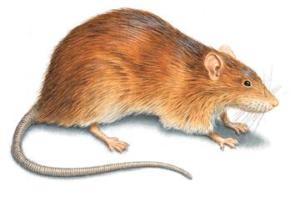How do they look like?
- Size: Their total length reaches 52cm, with their tail being 24cm. Their weight can exceed 500gr
- Colour: Norway rats have brown to gray colored hair.
- Characteristics: These rodents have thick hair. The ears and tail are covered with scales, with the tail being shorter than the body.
How did I get Norway rats?
Norway rats have the ability to gnaw on various materials in order to open a passage. Old and poorly maintained buildings have a higher risk of infestation.
What attracts them?
They dig with great ease and make underground nests. Attracted by:
- Gardens
- Dense shrubs
- High vegetation
How do they get in?
They invade our space from cracks and holes. The Norway rat can go through holes 1.5cm in diameter and more. They usually come from:
- Gaps around doors
- Gaps between pipes and wall
- Air conditioning system and cracks in walls
How dangerous are Norway rats?
Illnesses
They can transmit various diseases and parasites to humans.
Some are :
- Toxoplasma
- Hemorrhagic fever
- Cryptosporidation
Disasters
Norway rats can cause extensive damage to the interior of our homes. Some examples:
- Cutting power or internet cables
- Infection of food
- Furniture wear
The signs of infection
The most classic element is their feces. They are cylindrical, 2cm long. They mark their presence and their routes.
Typical is the bite of rodents on food, furniture and cables.
Where we have dark oily stains indicate high rodent activity.
If we see them during daytime it means we have a very high population. Also, any holes in the soil may be a nest entrance.
Πως απαλλάσσομαι από τους νορβηγικούς αρουραίους;
What can you do.
Here are some protection instructions.
- Sealing containers:Trash cans should be closed, as should containers containing human and pet food.
- Closing entrances:Doors and windows must be closed, especially at night when their activity is increasing. Possible gaps in frames and piping need to be repaired.
- Reduction of available food:Cleaning of food residues as well as pet food. It is important not to have animal feces nearby or outside our space.
- Minimize available water:Repair of any leaks and removal of stagnant water inside and outside our space.
What GeoProtect does
Almost all cases of Norway rat infestation require Integrated Pest Management. The specialized agronomist who will come, will first determine the type of pest and then will suggest the necessary suppressive actions. Depending on the case, chemical and / or non-chemical suppressants will be used. Some non-chemical agents that can be suggested are:
- Sealing: Repair of gaps and holes that allow Norway rats to enter.
- Hygiene: Removal of attractants.
- Traps: Mouse Traps
Finally, it is advisable to call a professional as soon as you notice a Norway rat infestation. Do not wait to take action, in a short time a small problem can become very serious.
Behavior, nutrition and habitat.
Where do they live?
Norway rats are nocturnal animals. We will not see them exposed during the day unless there is space constraint (overcrowding) or harassment.
These rodents excel in the human environment, especially in densely populated large cities.
Είναι κοινωνικά ζώα και κατοικούν σε ομάδες. Μπορεί η κοινωνία των νορβηγικών αρουραίων να μην είναι όσο εξειδικευμένη όσο των μυρμηγκιών, αλλά υπάρχουν κυρίαρχα και υποτελή άτομα. Οι φωλιές που κατασκευάζουν είναι υπόγειες και συνήθως κοντά σε πηγή νερού. Μπορούμε να τους βρούμε σε:
- Lofts
- Underground
- Water supply room of an apartment building
- Holes near the tree base
- Areas with dense vegetation
- Sewers
- Warehouses
What are they eating?
Norway rats are omnivorous. They can feed on a wide variety of foods, from fruits and nuts to other rodents and small fish. But they usually feed on:
- Corpses
- Fruit
- Seeds
- Meats
Reproduction and lifespan
They reach reproductive age in 2 to 5 months and reproduce throughout the year. Females can have 3 to 12 births per year and 4 to 22 newborns per birth. In the wild, adults survive for about a year.
Μπορείτε να βασιστείτε στο προσωπικό μας που θα κάνει ότι είναι δυνατό για να στείλει τους νορβηγικούς αρουραίους… από εκεί που ήρθαν! Καλέστε σήμερα στο :


